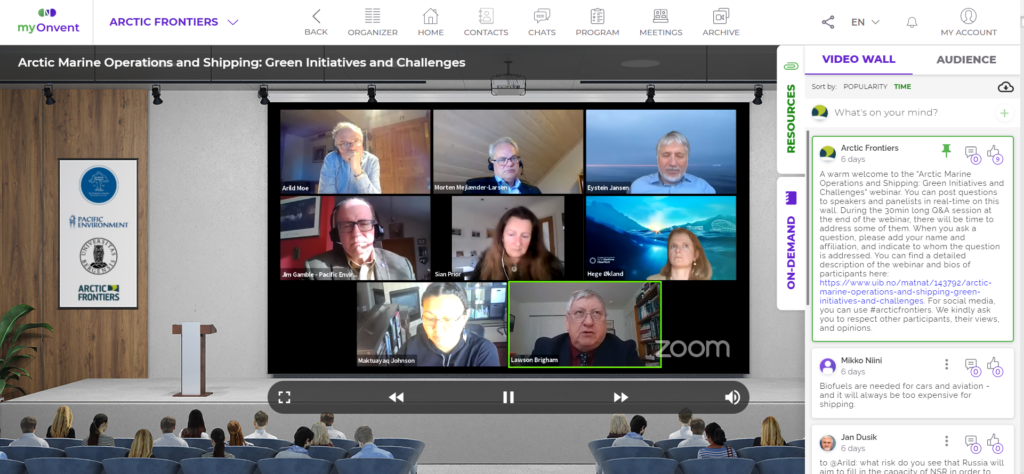The webinar “Arctic Marine Operations and Shipping: Green Initiatives and Challenges”, organised by the Academia Europaea Bergen Knowledge Hub (AE-Bergen), Pacific Environment, University of Bergen, and Arctic Frontiers on April 7th 2021, is now available as a recording. In this article, you’ll also find selected highlights.
Major economies aim to be carbon neutral by 2050. Such an ambition implies an almost full transition away from using fossil fuels to power the transport sector, including maritime transport. How will the maritime Arctic be influenced by global responses to climate change? The webinar, organised by the Academia Europaea Bergen Knowledge Hub (AE-Bergen), Pacific Environment, University of Bergen, and Arctic Frontiers on 7 April 2021, addressed maritime transport in the Arctic and provided insights into a complex set of issues: the Arctic policy framework for marine safety and environmental protection; indigenous and conservation perspectives; green ship technology; marine infrastructure; and, what measures are needed to make Arctic marine operations and shipping more sustainable.
Jim Gamble (Director, Arctic Programme Director of Pacific Environment) chaired the webinar, and Eystein Jansen (Professor at the University of Bergen, the Bjerknes Centre for Climate Research and Academic Director of Academia Europaea Bergen Knowledge Hub) served as a moderator.
A recording of the webinar is available below:
The full recording and discussion is also available in it’s original form on the Arctic Frontiers digital platform: https://myonvent.com/event/arctic-frontiers.
In his presentation titled “Challenges and policies for Arctic marine operations and shipping”, Dr. Lawson Brigham highlighted the complexity of marine operations and shipping. Arctic marine operations should be discussed in the context of global changes and trends, as the Arctic cannot be separated from geopolitics, climate change, sanctions, and other regional and global processes. In many cases, the infrastructure deficit and lack of hydrographic, ocean, and meteorological data are challenging for safe operations. Implementation of the Polar Code will be critical in the following decades to ensure the safety of marine operations and environmental protection.
During the presentation entitled “The green transition for arctic shipping”, Morten Mejlænder-Larsen pointed out that the decarbonization pathways of shipping depend on regulatory and policy measures, fuel prices, and future seaborne trade demands. As of today, we are still far away from starting a transition.

During the webinar, several experts highlighted the lack of Arctic infrastructure as a barrier to the green transition within the maritime industry.
The transition is expected to be costly. LNG is already used, primarily for deep-sea shipping. Ammonia and methanol are among the most promising alternative fuels in addition to sustainably produced biofuels. When it comes to engine technology, hybrid engines are becoming a new standard these days and bring many advantages for operations in the Arctic.
According to Hege Økland (CEO, Maritime CleanTech), 90% of shipping emissions come from international shipping. Due to the long life span of vessels, shipbuilders need to foresee future the upcoming regulations at an early stage, when ships are being planned and constructed.
Russia is the largest Arctic country, and hence the drivers of the development of the Russian Arctic are of great interest. According to Arild Moe, Research Professor at the Fridtjof Nansen Institute, it is essential to include Russian experts in the discussions focusing on the future technology and governance in Arctic shipping.
According to Dr. Moe, the primary traffic along the Northern Sea Route consists of destination shipping. The demand for international transit shipping remains somewhat unclear at this point as the economic benefit is uncertain.
Russia focuses on the development of Arctic transit shipping. While the Northern Sea Route is not a fully-fledged alternative to the Suez canal at the moment, it can serve as an option alongside the Suez as transit traffic picks up.
The Executive Director of the Bering Sea Elders Group, Mellisa Johnson, highlighted the concern that the local communities in Alaska have regarding the food safety of the locally produced food they harvest and trade. Increased shipping poses several environmental threats, such as risks of oil spills and disturbance of animals’ migration patterns. “The ocean is our grocery store. Marine vessel traffic can influence our way of life”, – said Melissa Johnson.
Dr. Sian Prior is a lead advisor at the Clean Arctic Alliance, which advocates for HFO (heavy fuel oil) free Arctic Ocean. Dr. Prior highlighted the concern that black carbon emissions have increased in the Arctic by 85% between 2015 and 2019. She further highlighted the need to switch to the other type of fuels. Such shift alone can account for a 40% reduction in black carbon emissions. The use of filters can reduce emissions even further. According to Dr. Prior, Arctic shipping can become a flagship for the rest of the world.
During the webinar, several experts highlighted the lack of Arctic infrastructure as a barrier to the green transition within the maritime industry. Regulatory aspects play a crucial role in the further implementation and scaling up of the existing technologies.
This webinar is the first step in a series of discussions ahead of the upcoming Arctic Frontiers 2022 conference. The work of Arctic Frontiers will traditionally facilitate pan-Arctic stakeholder engagement by linking business, policy, science, and society.
Furthermore, the theme of Arctic infrastructure will be among the core themes discussed during the conference in Tromsø in early 2022.
